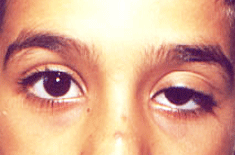| Ptosis |
 |
|
|
| |
 |
What is it? |
| |
Ptosis is a drooping of the upper eyelid. The lid may droop only slightly, or it may
cover the pupil entirely. In some cases, ptosis can restrict and even block normal vision.
It can be present in children as well as adults and may be treated with surgery. |
 |
What Causes it? |
| |
2-Adult ptosis may also occur as a complication of other diseases involving the
levator muscle or its nerve supply, such as neurological and muscular diseases and,
in rare cases, tumors of the eye socket.Congenital ptosis is often caused by poor
development of the levator muscle that lifts the eyelid.
Although it is usually only a
problem with a drooping eyelid, a child born with ptosis may also have eye-movement
abnormalities, muscular diseases, lid tumors, or other tumors, neurological disorders or
refractive errors. |
 |
Who are at risk? |
| |
Patients having Congenital (present since birth)drooping of eye lid due to a
poorly developed muscle. It is more common in older adults where the muscle that lifts
the eyelid thins and the eyelid drops. It occurs with age, contact lens wear, trauma and,
rarely, tumour or from a neurological problem, such as a nerve palsy or muscle weakness
(myopathy). |
 |
What are the symptoms & signs? |
| |
Ans 4- The symptoms of ptosis are a drooping of the upper eyelids. This can be in just
one eye, or it may affect both eyes.
Ptosis generally gives the face a tired or severe appearance. However, it can also result
in both dry eyes and watery eyes, as the eyelids are no longer functioning effectively to
keep the eyes moist.
At its most severe, ptosis can obstruct the vision, as the upper eyelid sags so much that
it begins to cover the pupil. Many people with severe ptosis find themselves tilting their
heads back to speak. Ptosis can also cause tiredness and aching around the eyes, as the
eyebrows are constantly lifted in order to see properly. |
 |
How is it diagnosed? |
| |
A physical examination will be done to determine the cause.
Tests that may be performed include:
Slit-lamp examination
Tension test for myasthenia gravis
Visual field testing. |
 |
What is the treatment? |
| |
If age-related ptosis blocks vision or seriously affects appearance, a plastic
surgeon usually can correct the problem by surgically raising eyelid. In most adult
patients, this is an outpatient procedure that is done under local anesthesia. Local
anesthesia is preferred over general anesthesia because it allows the surgeon to adjust the
position of eyelids while eyes are open.
If baby is born with severe congenital ptosis, doctor probably will recommend prompt
corrective surgery because early treatment reduces the risk of permanent vision
damage. If child has milder ptosis without impaired vision, however, the doctor may
suggest waiting until the child is 3 to 5 years old to correct the drooping eyelid. During
childhood, eyelid surgery is performed under general anesthesia.
If you have ptosis that is caused by a muscle disease, neurological problem or local eye
problem, your doctor will treat the illness. In some cases, this treatment either improves
the drooping eyelid or keeps it from getting worse. |
 |
What are the surgical options? |
| |
If a disease is found, it will be treated. Most cases of drooping eyelids are due to
aging and there is no disease involved.
Eyelid lift surgery (blepharoplasty) is done to repair sagging or drooping upper eyelids.
In milder cases, it can be done to improve the appearance of the eyelids.
In more severe cases, surgery may be needed to correct interference with vision.
In children with ptosis, surgery may be needed to prevent amblyopia, also called "lazy
eye." |
 |
What are the outcomes? |
| |
In most cases, the outlook is good. Surgery usually can correct the drooping
eyelid in children with congenital ptosis and adults with age-related ptosis. In some cases,
corrective surgery causes the eyes to remain open slightly during sleep, so a nighttime
lubricant is applied to the eyes to prevent drying.
|
 |
What are the complications? |
| |
In children, the most serious complication of ptosis is a lazy eye (amblyopia).
A lazy eye is when you can't see properly through one of your eyes. This is because the
developing brain ignores the image sent to it in favour of the image received from the
better-seeing eye. A lazy eye can be reversed, for example by correcting the position
of the lid. After the age of eight, the visual pathways have developed and it may be
impossible to reverse any loss of vision in a lazy eye.
Children can be more sensitive to the visible effects of a ptosis and the condition may
lead to emotional problems.
In both adults and children, ptosis can disrupt vision and making it difficult to carry out
everyday activities such as reading, navigating stairs or driving. For some people, this
may cause headaches, usually at the front of the head. |
 |
What is the time course? |
| |
Ans 10-The time course depends upon the severity and strength of ptosis. Ptosis is often
a long-term problem. In most children with untreated congenital ptosis, the condition is
fairly stable and does not get worse as the child grows. In people with age-related ptosis,
however, the drooping can increase gradually over the years. |
 |
What is the expense? |
| |
The expense depends upon the grades of treatment. |
|
| |
Author: Dr. Sanjay Dhawan
Last Updated on: 1 March, 2014 |
| |
|
|
|
